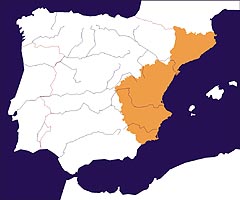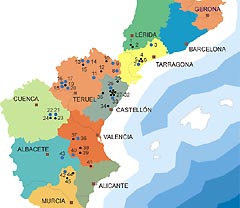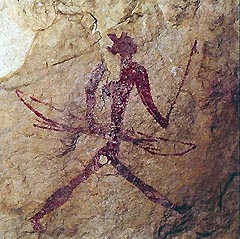|
Contribution of the Department of Prehistory, IH (CSIC) to EuroPreArt As it was before mentioned, the Department of Prehistory owns important documentary funds on prehistoric rock art, included in the Photographic Archive Martín Almagro Basch. Among them it is specially relevant the Corpus de Pintura Rupestre Levantina -Corpus of Levantine Rupestrian Painting- (CPRL), a collection of about 7000 pictures taken between 1970 and 1976 for a pictorial inventory project on Levantine Rock Art, directed by Professor Martín Almagro Basch. These pictures come together with plenty of contextual documentation, including maps, tracings and descriptions, and give information about 95 sites, distributed over the five Spanish regions in which this peculiar manifestations of postpalaeolithic rock art can be found (Aragón, Cataluña, Castilla la Mancha, Murcia and Pais Valenciano). Thus, they form the most important graphic resource available on Levantine rock art, with the valuable characteristic of presenting the conservation state of the paintings in a moment prior to the massive deterioration occurred in the last decades on this heritage. Unfortunately, in this period the total or partial destruction of some stations took place. Levantine painting is an original chapter of the European prehistoric art. It is characterized by its naturalistic style, its dynamic compositions on hunting and fighting scenes, and the abundance of human representations. It is always found in open air rock shelters, localized all along the Mediterranean side of the Iberian Peninsula. Its chronology has been debated since the first discovering at the beginning of the 20th century, being eventually considered palaeolithic, epipalaeolithic or neolithic, or even later according to different specialists. At the moment it exists some agreement on its parallel development to the neolithisation processes, taking place in the region about the 6th millenium BC. In 1998, the UNESCO incorporated the Levantine rock painting in its World Heritage list. Since 1991, a team from the Department of Prehistory, under the direction of Dr. Vicent García, is working on the recovering and dissemination of the CPRL, developing a pioneering project of application of new technologies of information. The funds have been thoroughly digitalized in order to ensure its conservation in the future and ease its dissemination through the recent publication on line of the image and information data base, and its inclusion in EuroPreArt. The participation of Department of Prehistory in this project consists of the contribution of a selection of the most representative images from the total amount of stations existing in the CPRL, as well as the most relevant contextual information about them. Thus, a global view of Levantine Rock Art is offered through some of its most outstanding creations. Address
Project Team
|

Map of the Spanish Levantine art area treated in EuroPreArt  Detailed map of the Spanish Levantine art area treated in EuroPreArt (click to enlarge) 
Barranco de las letras, Abrigo del Ciervo) |